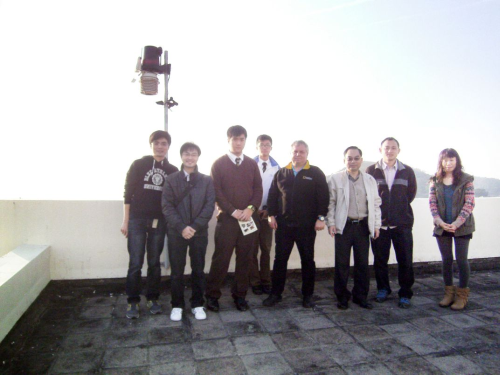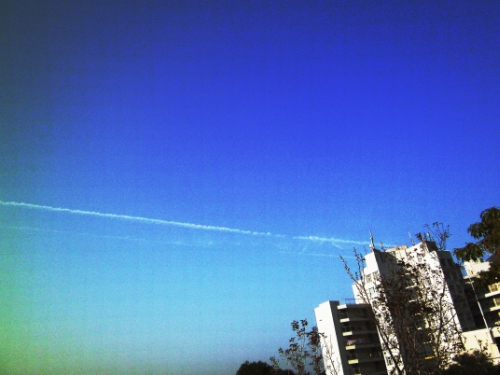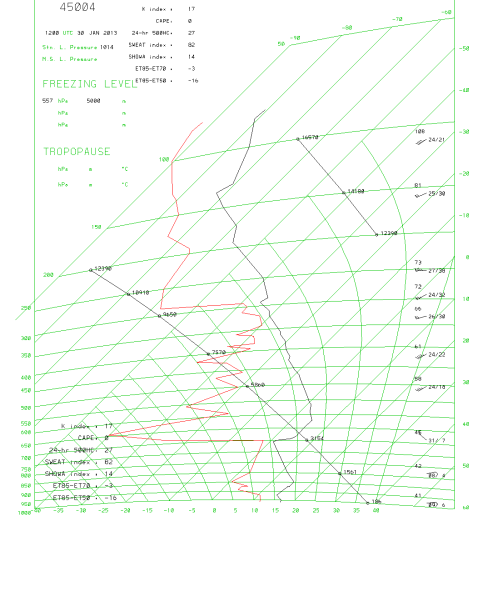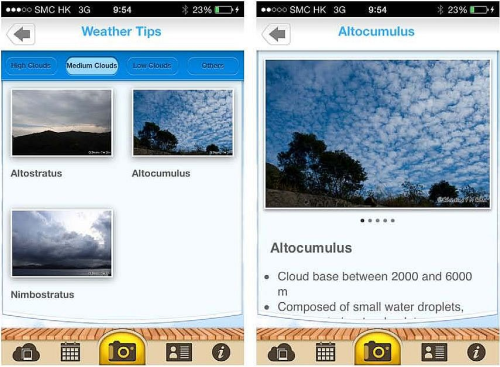As the Buddhist Fat Ho Memorial College at Tai Po joined the "Community Weather Information Network" (CoWIN) as a new member, staff of the Observatory and the Hong Kong Polytechnic University paid a visit to the school on 30 January 2013 (Figure 1) to offer expert advice on the set up of an automatic weather station there.

| Figure 1 | Group photo with the teachers and students of the Buddhist Fat Ho Memorial College nearby the automatic weather station of the school |
It was fine with blue sky on that day. During the visit, we looked up to the sky and saw a long and narrow band of white clouds persistently hanging at high altitude in the sky. It was a contrail (condensation trail) exhausted from an airplane (Figure 2). The teachers and students of the school were amazed and then took photos of the phenomenon and uploaded them to the "Community Weather Observing Scheme" (CWOS) Facebook page (Figure 3).

| Figure 2 | Contrail (Photo: Courtesy of author) |

| Figure 3 | Contrail appearing in CWOS Facebook page |
The hot airstream exhausted from an airplane's jet engine contains water vapor. The surrounding cold air in the atmosphere outside also contains more or less water vapor depending on the weather situation. When the exhausted air gets in contact with the very cold ambient air outside, tiny water droplets condense due to turbulent mixing and cooling. As a result, a condensation trail forms. As the air in the high altitude is very cold, most of the tiny water droplets quickly turn into ice crystals. Therefore, the contrail appears white like snowflakes or cirrus clouds.
If the surrounding air along the flight path of the airplane is dry, the contrail produced will contain smaller amount of tiny water droplets or ice crystals. These tiny water droplets or ice crystals will evaporate more readily into the surrounding dry air, resulting in transient or un-obvious contrail. On the contrary, if the air along the flight path of the airplane is humid, the contrail produced will contain larger amount of tiny water droplets or ice crystals, resulting in more persistent and observable contrail. Since the contrail observed on that day was persistent and obvious, the ambient air along the flight path should be relatively humid. Referring to the atmospheric sounding data (Figure 4) measured by a radiosonde on that evening, the atmosphere was generally dry such that the weather was fine. However, it is noted that the air at altitudes between about 320-350 hPa pressure level (equivalent to around 8500-9200 m altitude) was relatively humid with sub-freezing air temperatures. So, it is estimated that the airplane was probably cruising at around 8500 to 9200 m altitude at that time.

| Figure 4 | The atmospheric sounding data measured by a radiosonde on 1 January 2013 evening |
The aim of CWOS is to encourage members of the public to acquire weather knowledge as well as be more aware of weather-related hazards and climate change through participation in making weather observations. CWOS is also a useful platform for CoWIN members to share their weather observation information. In addition to contrail, a lot of excellent photos related to weather observations are also shown in the CWOS Facebook.
Furthermore, the Observatory has updated the free mobile application of "iCWeatherOS" on iPhone platform in January 2014. Apart from providing a platform for users to upload weather observations to CWOS Facebook, there is now a new page at "iCWeatherOS" for users to learn more about "Clouds in Hong Kong" (Figure 5). The Android version of "iCWeatherOS" will be coming soon. Please stay tuned!

| Figure 5 A new page introducing "Clouds in Hong Kong" at "iCWeatherOS" application |
